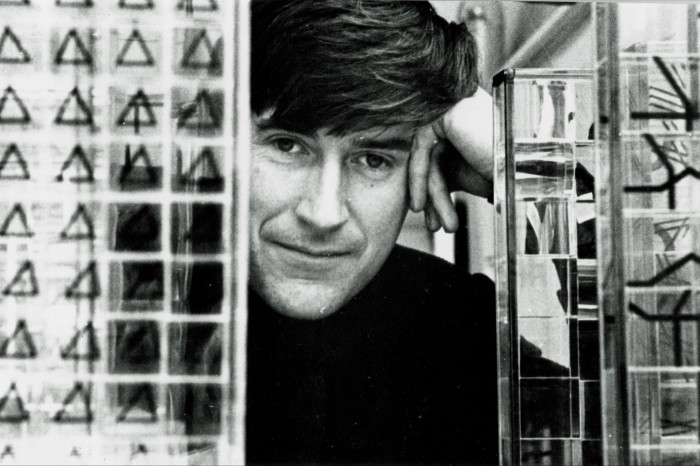Dead leaves are underfoot, on urban pavements, in rural fields and wherever we do not want them in gardens. In London we kick away leaves fallen from plane trees, and everywhere we rake leaves briskly off our lawns. We do not go slowly and look at them closely.
Slow walking and close looking helped the greatest botanical artist in my lifetime to turn flowers and dead leaves into masterpieces. Rory McEwen died in 1982, aged 50, but his reputation and influence as a botanical artist have grown with each retrospective exhibition. An excellent show of his work is currently touring the US, from Charleston to Florida and then Chicago from May 17 to August 17 next year.
Until December 15 it is in the Davis Museum at Wellesley College, Massachusetts, where it is admirably presented against high white walls. For its opening, undergraduates of this women-only college wore flower-themed dresses and decorations, a new twist to McEwen’s impact. Next year a smaller exhibition will begin at London’s Garden Museum. Meanwhile a fine exhibition catalogue is on sale, Rory McEwen: A New Perspective on Nature, beautifully illustrated with support from the Mellon family’s Oak Spring Garden Foundation. It is graced with a foreword by Ruth Stiff, curator of international exhibitions at Kew, and an exceptional essay by Martyn Rix, botanist and expert in botanical art, who was a friend and guide to McEwen for many years.

McEwen was born into the British upper class, spending a wartime childhood in the grounds of Marchmont House, a mansion on the Scottish borders. He was the fourth of seven children, a spur to his own achievements. He became a fine musician, singing and playing the guitar, a talent that predominated in his undergraduate years at Cambridge. He profoundly admired Lead Belly, the legendary 12-string guitarist and singer from the American South, then little known in Britain. His musical interrelationships are a subject in themselves, from his meeting with Lead Belly’s widow in New York, to his appearances on an admired BBC TV show in the early 1960s, and the company he kept at his house in Chelsea. There, the Beatle George Harrison first met and learned from Ravi Shankar, the Indian sitar-player, a visitor housed by McEwen and his family.
Guitar playing requires precision and persistence. They are qualities that botanical art needs too. McEwen recalled that he began to paint flowers at the age of eight thanks to his French governess: the exhibition includes a leaf he painted then, already notably. At Eton College, he was lucky to be guided by the art master Wilfrid Blunt, a skilled botanical artist and historian of the subject. Crucially he made McEwen aware of the long history of the genre, from early herbals and religious books to the great master Pierre-Joseph Redouté and others. McEwen looked at hundreds of prints and originals of their work and studied their techniques. His close analysis of these forerunners distinguishes his art from simple illustration. So do the depth of his eye and the material on which he painted.
“I have never really been interested in botanical illustration per se,” he wrote in older age to Blunt, “but rather in that moment when painting starts to breathe poetry.” Viewers of his work need to look at it with this moment in mind. Botanical art aims at exact representation and is distinct from flower painting, whether Monet’s water lilies or Cedric Morris’s irises. McEwen saw exactness as a gate to meaning.
Most of his painting is in watercolour on vellum, the least forgiving of white surfaces, one rarely used in the 1960s. With its help he contrived a luminous effect, especially in the leaves of plants he painted. For hours on end, he worked with extreme discipline in an attic or studio, listening to music through headphones, his guitar propped against the wall, taking second place from 1965 onwards. He would emerge with his charm and energy unimpaired and engage smoothly with his family and many guests.

In due course he travelled east, not only to Japan which fascinated him and where exhibitions of his work were greatly admired. He loved spending time in Afghanistan, India and Bhutan, where he soon needed a butterfly net: the queen of Bhutan ordered one to be made for him from a piece of her mosquito netting. In the 1970s he kept small images of Buddha on his desk, befitting his contemplative eye while painting so meticulously. He looked and thought deeply.
In 1958, he married Romana von Hofmannsthal, an Astor on her mother’s side. The spectre of an office job receded and he could play, sing and paint as he wished. Like the folk songs he performed, some of the flowers that he presented had roots in popular culture. To find living old-fashioned tulips he joined the Wakefield and North of England Tulip Society. In 1962, with his wife Romana’s help, he had his first exhibition in New York which was admiringly reviewed for its “grace and exactitude” in The New York Times.
It drew two remarkable visitors, Bunny Mellon, hyper-rich collector of botanical books and art, and through her, Jackie Kennedy, with whom McEwen, aged 30, discussed his tulips. Mellon then bought his masterly painting of four carnations, rendered from plants from Allwoods nursery in Sussex, and one of tulips from the Wakefield Society. She sent them to the Kennedys at the White House where they hung in private rooms. Ever a thoughtful correspondent, McEwen wrote to the Wakefield Society, telling them of his delight that “so long as the White House stands the Wakefield Society’s tulips will be hanging on the wall”. Actually they were loans from Mellon, not gifts, so they are in the exhibition with other treasures from her Garden Foundation.

In Massachusetts, I admired a follower’s picture of Tulipa “Rory McEwen”, violet on white and difficult to grow well. I then returned to the entrance. The security guard remarked that I was not the first visitor from England: a lady had just come specially from Wakefield in the north. How apt, as the two of us relate to two of the artist’s supreme subjects. In 1977, McEwen went with Rix to see a wild meadow of purple and white fritillaries in Hampshire and soon after, we met socially. He noted in his diary that I had once told him that it “is the one flower it is impossible to paint”. Before long, with habitual kindness, he sent me his reply, a perfectly painted Fritillaria meleagris. Others, taller and bigger, are in the current show.
“A lot goes on in a dying leaf”, he wrote to his niece, “you’d be surprised”. A superb series of paintings, “True Facts From Nature”, included one such leaf in 1973. From late 1977 he excelled with them, placing them carefully off centre on white vellum, his considered response to the surrounding minimalism of modern art. He saw them not as dying, but as “showing the marks of life and experience,” like “tiny condensations of the places from which they came”. He noted exactly where he found these late models, leaves with addresses in New York, Chelsea or the playing fields of Eton. Diagnosed with cancer, then a brain tumour, he wrote that he was making a connection between the “experienced” object and human thoughts and feelings and in that sense his work was indeed “abstract”. I have just examined a sycamore leaf on my path. Through his final masterpieces I see so much more of what is going on there.
Find out about our latest stories first — follow @ft_houseandhome on Instagram













































































































































































You must be logged in to post a comment Login